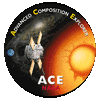

7Be and 7Li are produced at the Sun in alpha-He fusion in flares. The production of these nuclei at the Sun can be monitored by de-excitation lines at 0.438 and 0.477 MeV which have been detected by gamma-ray spectrometers on NASA's Solar Maximum Mission and Compton Gamma Ray Observatory satellites. The fluence in the combined line feature is on average about 5 times higher than expected under the assumption that both the accelerated alpha particle/proton and ambient 4He/H ratios are 0.1. These gamma-ray measurements suggest that energetic Be and Li nuclei produced at the Sun with energies above ~4 MeV may be detectable by the SIS and/or ULEIS instruments on ACE. Fluences of ~500 particles/cm2 may be emitted in the strongest flares. It has also been suggested that these solar nuclei may be a source of a surprisingly large concentration of radioactive 7Be found in the upper atmosphere on the LDEF satellite in 1989 following an intense period of solar activity. We propose to search for 7Be and 7Li in impulsive solar energetic particle events observed by ACE and to correlate these measurements with gamma-ray observations made on the Compton Gamma-Ray Observatory and Yohkoh. The intense 1997 November 6 flare was observed in gamma rays by Yohkoh and provides the first opportunity for such a comparison. We will also compare these measurements with in-situ observations of 7Be derived from US and Russian exposure of foils to the rarefied atmosphere at LEO.
We also plan to evaluate the possibility of using highly broadened gamma ray line features to determine the composition of heavy nuclei interacting at the Sun; this could be compared with the composition measured in SEP's by ACE.
Our Email Address: asc@srl.caltech.edu